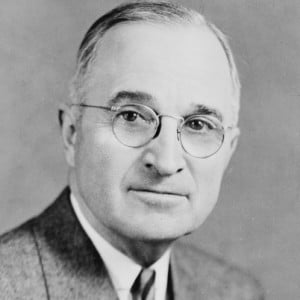U.S. Presidential Lying Is Nothing New

Donald Trump certainly lies more often, and sometimes for the most trivial or ego-driven reasons. But presidential prevaricating is a common tactic dating back to the nation’s early days.
After escalated provocations with Mexico until he obtained the necessary pretext in 1846, President James Polk announced, “War exists,” thus explaining away how it really happened. After defeating Spain, William McKinley said he wanted to “uplift and civilize and Christianize” the Filipinos, and “by God’s grace do the very best we could by them.” But they’d already declared independence, so doing the “best” actually meant allowing the worst — killing and burning villages during a 12-year war of resistance.
 In 1947, Harry Truman (image right) wanted to “assist free peoples to work out their own destinies in their own way.” But the pledge didn’t stop him from approving CIA manipulation of elections in Greece and Italy. And when asked about a US operation to overthrow the Guatemalan government of Jacobo Arbenz in 1953, the State Department called the charges ridiculous and untrue. This saved President Eisenhower the burden of lying about it himself. In his memoirs, however, Ike stepped up, still denying that the US had anything to do with the coup.
In 1947, Harry Truman (image right) wanted to “assist free peoples to work out their own destinies in their own way.” But the pledge didn’t stop him from approving CIA manipulation of elections in Greece and Italy. And when asked about a US operation to overthrow the Guatemalan government of Jacobo Arbenz in 1953, the State Department called the charges ridiculous and untrue. This saved President Eisenhower the burden of lying about it himself. In his memoirs, however, Ike stepped up, still denying that the US had anything to do with the coup.
President Johnson’s most famous lie was his 1964 announcement that two US destroyers had been attacked in the Gulf of Tonkin. This trumped up incident provided a pretext to escalate war in Vietnam. The following year, he railed about “atrocities” in the Dominican Republic. The reports weren’t true, but it gave him an excuse to occupy the country.
Nixon, of course, misled Americans about many things, from bombing Cambodia to covering up dirty tricks. But Reagan was equally adept. The Organization of Caribbean States pleaded for the 1983 US intervention in Grenada, he once claimed. Actually, the pleading came from the other side. He also repeatedly denounced the Russians for spraying toxic chemicals over Afghanistan. As it turns out, pollen-laden feces had been dropped by honeybees over Laos and Cambodia. Afghanistan wasn’t even affected.
Experts differ over whether the first war with Iraq was a set up. But there’s no dispute about George Bush’s 1988 claim that he never met Manuel Noriega, not even when he was CIA director. He was later forced to admit the truth.
Clinton certainly lied about “having sex with that woman.” But more crucial deceptions escaped much notice. Bombing a Sudanese drug factory in 1998, for example, he called it a front for nerve gas production, an assertion that proved false. More crucial, he didn’t mention that the US had been conducting a covert campaign to destabilize Sudan’s government for two years, passing on military equipment to the Sudan People’s Liberation Army. That was a touchy subject, since the guerrillas were using women and children as forced labor, mortaring urban areas, killing relief workers, and shooting down civilian airliners.
 As for Bush, the full scope of his misadventures with candor is hard to cover in one short article. But it clearly started before his crusade to oust Saddam Hussein. One earlier example was his relationship with Enron’s Kenneth Lay, much closer than he chose to admit after it disastrous and bogus bookkeeping was exposed.
As for Bush, the full scope of his misadventures with candor is hard to cover in one short article. But it clearly started before his crusade to oust Saddam Hussein. One earlier example was his relationship with Enron’s Kenneth Lay, much closer than he chose to admit after it disastrous and bogus bookkeeping was exposed.
As the rationale for US intervention in Iraq unraveled, outrage and disbelief were expressed over the possibility that Bush and his team had “misled” Congress and the public. That leads a related question. When Bush asserted in his 2003 State of the Union address that Saddam Hussein was seeking African uranium, was he just misinformed or purposely deceiving the public?
Whichever is true, he and administration spokesmen clearly asserted that Iraq was a) responsible for the 9/11 attacks, b) directly linked to al-Qaeda, c) trying to import aluminum tubes to develop nuclear weapons, d) hiding vast stocks of chemical and biological weapons from the first Gulf War, e) capable of developing smallpox, f) obstructing weapons inspectors, and g) able to deploy weapons of mass destruction in 45 minutes. None of this turned out to be true.
Examples could certainly be added from the Obama years, perhaps starting with the denial of complicity in the overthrow of Honduras’ president early in his administration. “You can keep your plan” also comes to mind. In any case, this sordid record is meant to indicate that presidents frequently resort to fabrication and mendacity in shaping public opinion. But even impeachment isn’t likely to change that, since many of the biggest lies are embraced, at least initially, by most members of Congress, and disseminated without sufficient scrutiny.
The real problem is the presidency itself. As Historian Barbara Tuchman suggests, it has become too complex and powerful to be left to the “fallible judgment of one individual.” Yet if the past is a guide, one thing seems sure: Whether it’s Trump or someone more “normal,” presidents will continue to mislead us until more effective limits on executive power are imposed.
Greg Guma is the Author of Dons of Time, Uneasy Empire, Big Lies, and The People’s Republic: Vermont and the Sanders Revolution.

